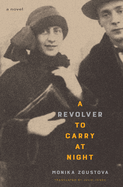
With A Revolver to Carry at Night, Monika Zgustova (Dressed for a Dance in the Snow) examines the life of a fictionalized Véra Nabokov, necessarily in relation to the famous husband whose career she helped shape. Zgustova offers snippets of the lives of Véra and Vladimir, including both mundane and life-changing moments, alongside their son, Dmitri; Vladimir's one-time lover Irina Guadanini; and the Nabokovs' friend Filippa Rolf. Translated from the Spanish by Julie Jones, this brief but absorbing novel is both terse and expressive.
The novel consists of four parts, set in 1977 Montreux; 1937 Cannes; 1964 Boston and New York; and finally Montreux in 1990, following Vladimir Nabokov's death. These nonchronological sections allow for various perspectives on the same events, like the couple's first meeting. In Zgustova's telling, Véra orchestrated the relationship and the marriage from the start. A Revolver to Carry at Night is told in a close third-person narrative, shifting perspective among Véra, Vladimir, and others, allowing readers to become engrossed in the various characters' thoughts and feelings.
Véra is ambitious, complex, controlling, and not necessarily likable. In the absence of her own creative career, she privately takes credit for her contributions to Vladimir's. The titular revolver is a literal object Véra carries as well as a symbol of her insecurity and tough exterior.
Based on events from the Nabokovs' real lives, A Revolver to Carry at Night offers insight as well as imagination into the life of a strong woman who fought for what she wanted. It is not always flattering, but its subject would appreciate the hard-nosed lack of sentimentality. --Julia Kastner, librarian and blogger at pagesofjulia

